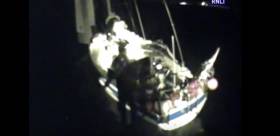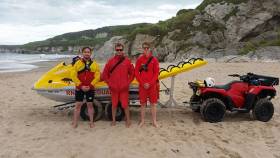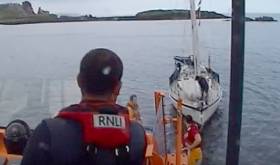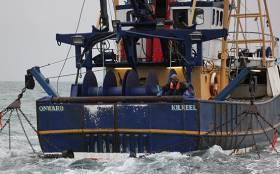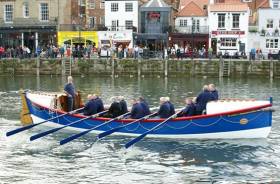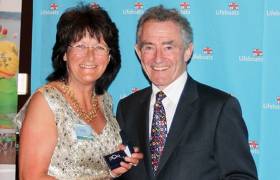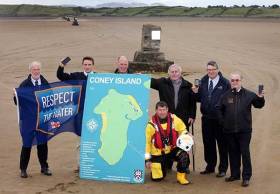Displaying items by tag: Lifeboat
Larne RNLI Rescues Three Yachtswomen After Yacht Gets into Difficulty off Antrim coast
Larne RNLI rescued three people late last night (Friday 29 July) after their 6m yacht got into difficulty off the Antrim coast.
The three women were on passage from Norway to the Caribbean having come through the Caledonian canal, and were heading to Belfast when they encountered problems.
The crew raised the alarm at approximately 11.30pm when their yacht was becalmed having sustained engine failure seven miles north east of Larne.
The all-weather lifeboat under Coxswain Norman Surplus launched at 11.45pm and made its way to the scene near the Highland perch, an area far from the coastline known to be hazardous for its shallow water.
Weather conditions at the time were described as excellent with light to no wind blowing and good visibility despite it being dark.
On arrival, a volunteer lifeboat crew member transferred onto the yacht where he first checked that the three on board were safe and well.
The lifeboat crew then proceeded to work with the vessel’s crew to establish a towline before the lifeboat brought the yacht into the safety of Larne harbour. On arrival the all-weather lifeboat was met by the station’s inshore lifeboat which assisted at the end of the call out to put the boat on the mooring.
Speaking following the call out, Larne RNLI Coxswain Norman Surplus said: ‘The three women did the right thing tonight and raised the alarm when they got into difficulty and thankfully all three are safe and well and we would like to wish them a safe onward journey.
‘We would encourage anyone visiting the coast this summer, to remember to respect the water. When sailing, always have a means for calling and signalling for help and ensure everyone onboard knows how to use it. Always check the weather forecast and tide times. Make sure someone ashore knows where you are going and who to call if you don’t return on time. Learn how to start, run and maintain your engine and always carry tools and spares.’
Lough Derg RNLI Lifeboat Assist Seven people on 15–ft RIB
Lough Derg RNLI Lifeboat launched at 10.20pm yesterday evening to assist seven young people on board a 15ft–RIB (Rigid Inflatable Boat) with engine difficulties near Coolbawn Quay, on the eastern shore of Lough Derg.
Winds were westerly, Force 3, visibility was poor, with imminent nightfall.
At 10.30pm the lifeboat, with helm Peter Clarke, Eleanor Hooker and Keith Brennan on board, located the vessel by Illaunmor. The seven people on board were unharmed, but feeling chilled and were wrapped in towels. Survivor lifejackets were distributed to those who had none. An RNLI volunteer boarded the RIB and one of the casualties was taken onto the lifeboat. The lifeboat towed the RIB with her passengers to Dromineer.
Peter Clarke, Helm at Lough Derg RNLI Lifeboat, advises lake users to ‘respect the water, to carry enough lifejackets for everyone on board and to ensure they wear them, and to regularly service their boat’s engines’.
The Lifeboat returned to station and was ready for service again at 11.40pm
In a dramatic rescue on Whiterocks beach at Portrush in County Antrim yesterday three RNLI lifeguards rescued two body boarders from rocks. In waves that reached well over head height the lifeguards launched their Rescue Water Craft and brought the two men to safety. The rescue occurred during one of the hottest days of the year which brought hundreds of people to the coast to enjoy the good weather.
The alarm was raised at 4.30pm when a member of the public contacted RNLI Lifeguard Stephen Parish to say that two body boarders where trapped at the mouth of a cave at the east end of the beach. Steven and his two colleagues on duty, Ali Boyd and Bosco McAuley, were finishing an exercise when the call for help was made and they immediately swung into action.
RNLI lifeguard Ali Boyd drove the Rescue Water Craft while Bosco McAuley accompanied him as crew. They proceeded to the scene some 500 metres offshore where a heavy swell made it impossible to bring the rescue craft close to the trapped pair. With the waves breaking over the men’s heads, the lifeguards waited until there was a lull in the set before Bosco jumped into the water and swam to the rocks. The first man went into the water and was brought by Bosco to the waiting rescue craft. The three of them immediately returned to shore before the two lifeguards headed straight back to the scene to recover the second casualty.
By this time the second man was showing signs of exhaustion and the lifeguards kept a tight hold of him as they recovered him, with Bosco once again swimming out to him while Ali kept the rescue water craft close-by, circling to ensure he stayed clear of the waves and avoided the rocks.
When back on shore both men were brought to the Lifeguard hut and were administered casualty care.
Commenting on the callout RNLI lifeguard Bosco McAuley said, ‘It was a busy day on the beach yesterday and we are always conscious that there can be things happening anywhere at anytime. We had just finished an exercise and were able to launch the Rescue Water Craft immediately. Despite the warm day, the sea swell was huge with massive waves breaking over the heads of the body boarders as they waited on rocks. They had managed to scramble on these rocks when they got into difficulty and were able to wait for help. This was a rescue where every second counted and thankfully these two men are now home safe and well.’
Howth RNLI Rescue Yacht Aground with 7 People Onboard
Howth RNLI launched at 1.15pm Thursday 14th July 2016 to reports of Sailing Yacht with 4 adults and 3 children aground just off Ireland Eye.
The casualty vessel was quickly located and towed to safety.
The request to launch came at 1.15pm and the Howth RNLI all-weather lifeboat proceeded outside the harbour and quickly located the yacht aground in Howth sound. The 32ft Sailing yacht had 4 adults and 3 children aboard. All were wearing lifejackets.
Weather was excellent with overcast clouds but good visibility. The sea state was calm with little or no wind present. The tide was quite low with another hour to go to low tide.
Howth RNLI volunteers Fin Goggin and Stephen Mullaney threw a tow line to the casualty vessel which was then secured and Howth RNLI Coxswain Fred Connolly used his driving skills to safely tow the casualty vessel off the rocks with little or no damage. When clear the sailing yacht was able to make its own way back to Howth Harbour.
Howth RNLI Lifeboat Operations Manager Colm Newport says: ‘A quick call was made by the skipper of the yacht as soon as he got into difficulty which showed good seamanship. These things happen and we were delighted to be able to assist.”
Lough Derg RNLI Launches for Cruiser On The Rocks
Lough Derg RNLI Lifeboat launched to assist a person on board a 30ft–cruiser, aground at Gortmore Point, at the north-eastern shore of Lough Derg yesterday morning.
Valentia Coast Guard requested Lough Derg RNLI Lifeboat to launch to assist a person on board a 30ft cruiser that had gone aground on Lough Derg, south of Portumna
The lifeboat launched at 10.45am with helm Eleanor Hooker, Ger Egan and Lorna Walsh on board. Winds were west-southwest, Force 3/4, visibility was good.
The lifeboat located the vessel at Gortmore Point, on the north-eastern shore of Lough Derg. The person on board was safe and unharmed, but distressed. They were wearing their lifejacket.
An RNLI volunteer climbed across and provided reassurance. The RNLI crew member checked the boat for any damage, and once satisfied the cruiser was not holed, set up a tow.
The cruiser was taken off the rocks and out into safe water, where the drives and engine were checked and found to be in working order.
With two RNLI volunteers on board the casualty vessel with its skipper, the lifeboat accompanied the cruiser to Dromineer harbour.
Brendan O’Brien, Deputy Launching Authority for Lough Derg RNLI Lifeboat, advises lake users ‘who find themselves in difficulty, to dial 999 or 112 and ask for Marine Rescue’. ‘The RNLI Lifeboats and its volunteers provide 24hr rescue service, every day of the year.’
Lough Swilly RNLI Officially Name New Shannon Class Lifeboat 'Derek Bullivant' in Buncrana, Donegal
The first Shannon class RNLI lifeboat to go on service in Ireland was officially named today in a special ceremony attended by crowds of people in Buncrana, county Donegal. The €2.4m life-saving vessel has already been on nineteen callouts since its arrival on the North-West Coast last year and today it was officially named the ‘Derek Bullivant’ by the man responsible for getting the RNLI’s latest class of lifeboat named after an Irish river.
Arklow man Jimmy Tyrrell was with the RNLI for 46 years, making him the charity’s longest serving lifeboat operations volunteer on his retirement. He campaigned to have the RNLI name a class of lifeboat after an Irish river, in recognition of the service and dedication of Irish lifeboat volunteers. His wish was finally realised with the design and manufacture of the Shannon class lifeboat. The first of the class went on service at Dungeness in Kent back in 2014 .Jimmy was asked by Lough Swilly RNLI to officially name the lifeboat and he did so through the time honoured tradition of pouring champagne over the bow of the lifeboat to cheers from the crowd.
It was an emotional day for Jimmy, whose family are well-known and respected boat builders, as it is the culmination of a 27-year campaign to name an Irish lifeboat class. Speaking at the ceremony he said, ‘During my lifeboat career I have seen many changes in lifeboats, from wood, to steel, to fibre-glass and to today’s composite construction. Lifeboat speeds varied from eight-knots going downhill with the wind up your transom to this wonderful new waterjet propulsion achieving 25-knots. However, one thing that has not changed in the RNLI and that is its people. The basic commitment of crews is the same. Generations of them have put their lives on the line and sometimes lost their lives trying to help those in peril on the seas.’
A small service of blessing followed led by Fr Francis Bradley, Parish Priest of Buncrana and Reverend Judi McGaffin, Church of Ireland Rector.
The Donegal lifeboat station was the first in Ireland to receive the new lifeboat, which is the most modern and technically advanced lifeboat in the RNLI fleet. The Shannon is first class of lifeboat to be propelled by waterjets instead of traditional propellers, making it the most agile and manoeuvrable all-weather lifeboat in the fleet. The lifeboat has a top speed of 25 knots and a range of 250 nautical miles. The lifeboat was developed to operate in the worst of sea conditions and is self-righting, automatically turning the right side up in the event of a capsize.
The Derek Bullivant lifeboat (ON 1315) was funded by legacies from Mr Derek Bullivant and Mrs Valerie Walker. Mr. Bullivant was born in Birmingham in 1922 and went on to establish one of the biggest aluminium recycling companies in the UK. He wanted his success to benefit lifesaving and humanitarian charities which led him to provide a generous legacy which helped to fund the Lough Swilly lifeboat. The second legacy was bequeathed from Mrs. Valerie Walker from Portsmouth. Mrs. Walker was a supporter of the RNLI and her legacy has been used to part fund the lifeboat. A plaque honouring her will be placed in the lifeboat station.
Accepting the lifeboat, Lough Swilly RNLI Lifeboat Operations Manager John McCarter said, ‘While we are in celebratory mood today God knows we have seen and been closely involved in our share of tragedy around our community, and we remember all those who have suffered great loss at the mercy of the sea. However at Lough Swilly RNLI it also strengthens our resolve to work harder and keep our equipment state of the art to enable us to provide search and rescue service around our coast. The Derek Bullivant lifeboat is testament to that.’
‘There are thirty volunteers at Lough Swilly RNLI. A number of our crew have been here from the beginning as young boys and girls and matured with the station where they now have families and potential new volunteers coming on themselves. Today is a very proud day for all of us here at Lough Swilly RNLI and I am absolutely delighted on behalf of all at Lough Swilly to accept this new Shannon Class boat the RNLB Derek Bullivant into our care.’
In the 29 years since Lough Swilly RNLI was established they have launched 741 times, brought 568 people to safety and saved forty-nine lives.
Fishing Safety Event to be Held in Kilkeel
The Royal National Lifeboat Institution (RNLI) have joined with the Maritime Coastguard Agency (MCA), the Fishermen’s Mission and Seafish, the group responsible for the promotion of the fishing industry, to hold a fishing safety event in Kilkeel, County Down next month.
The event will be held at 11am on Friday 8th July 2016 in the Fishermen’s Mission centre in Kilkeel. It is open to all fishermen to attend and is free of charge.
RNLI Fishing Safety Manager, Frankie Horne will lead the event which will involve a demonstration and discussion focused on safety in the fishing community. It will take an in-depth look at the areas where fishermen are being seriously injured or losing their lives fishing. This year has already seen fatalities in the industry.
The demonstration and talk will focus on the areas of stability, safety awareness and deck machinery. The RNLI have run a number of campaigns in the past aimed at fishermen. Last January the charity launched a hard-hitting campaign encouraging fishermen to make sure their boats kept them safe at sea.
RNLI Fishing Safety Manager Frankie Horne said, ‘I have been a fisherman for 37 years from cook, to deck hand to skipper/owner. I am also a volunteer lifeboat Coxswain at Peel RNLI on the Isle of Man. We are working with fishermen on how to make their industry safer. This starts with the fishermen themselves and with us listening to and addressing their concerns.’
‘We want the fishermen to help us solve the safety problems in the industry that lead to loss of life, or life-changing injuries. Fishing is still the most dangerous peace time occupation and we all have a collective responsibility to make fishing safer.’
One of the country’s largest celebrations the coast, the Wexford Maritime Festival is set to host five vintage lifeboats later this week from June 24th to 26th as the vessels voyage to Wexford from across Ireland and the UK.
The 100 year old ‘Whitby’ lifeboat will arrive for display during the festival weekend along with former Royal National Life Boats the ‘Canadian Pacific’ from Kyle of Lochalsh, ‘J. W. Archer’ from Wales and the ‘Joseph Soar’ from Coleraine. The antiquated lifeboats will take pride of place on the Quayside in Wexford town alongside a Wexford's maritime heritage showcase at the festivals Maritime Model Village where an exhibition on Vintage Transport through the lens of Robert Shorthall with over 100 model boats and aircraft will be on display.
Wexford Maritime Festival offers festivalgoers an action-packed programme of events on Wexford Quays, with everything displays of maritime heritage to opportunities to try a new watersport along with search and rescue displays to stunt aircraft taking to the skies.
Commenting on the upcoming weekend one of the festival organisers Lorraine Galvin says, “We are set to welcome over 40,000 people to the festival, most of our events are on offer for free or for a nominal price with all proceeds from this event being donated to the RNLI. This is the fifth year of the festival and the programme is our biggest yet, we are also expanding the programme by a day as we run from Friday right through until Sunday evening this year. This festival is a wonderful opportunity to celebrate our 275 kilometres of coastline here in Wexford.”
The festival launches on the Friday evening with a Gala Banquet hosted by the Wexford Food Family with celebrity chef Phelim Byrne. In all 38 festival events will take place, highlights inlcude Rescue Saturday where a major Search and Rescue display with aircraft, lifeboats and ambulance crews showcase their capabilities and skills. Along with a large Emergency Services Village, visitors can meet the crews and see their equipment including the first visit by the Irish Armys Mowag Piranha IIIH 8x8 armoured personnel carrier, Irish Coast Guard, RNLI, Defence Forces, Civil Defence, Gardia, Wexford MarineWatch, Seal Rescue, HSE.
Fun-day Sunday sees a spectacular stunt show with formations with two RV 7 aircraft with gravity defying, jaw dropping displays take to the skies above the Quayside.
A ‘Try it Dock’ will be on offer in the Maritime Village with local water sports groups taking people out to try out some new waterbased. Wexford Sub Aqua club will host a free try a dive Sunday 26 at 4.45 p.m. and the ever popular Raft Races take place on Sunday afternoon for teams of six.
A rowing regatta and sailing regatta will also take place and a flyboarder 'Ironman’ will quire literally walk on water. And for the landlubbers, lots of activities will be on offer shoreside with food and music to the fore with Wexford band Corneryboy and SoulTrek and the Funk Generation will entertain the messes along with a Big Barbeque bash for a summer festival vibe.
The Childrens Village welcomes fun activities including Art and Colouring, Crazy Games, Disco Fun, Wobbly Circus Show, Viking Village and Recreate Environment Workshops.
RNLI Honours Dublin North Volunteers at Irish Awards
The RNLI held its Annual Presentation of Awards at the Guinness Storehouse on Friday (17 June 2016) where the charity presented 56 individual awards to volunteers from across the country. Five of the awardees were from Dublin North. However the ceremony was tinged with sadness for Howth RNLI representatives as one of the recipients, Ms Rosemary O’Neill from Howth RNLI, had passed away a few days before she was due to receive her Gold Badge for fundraising. Howth RNLI Lifeboat Management Group Chairman Russell Rafter accepted the award on her behalf to warm applause from the crowd.
The awardees were honoured for their significant contribution to the RNLI in Ireland and years of dedicated and committed service to the charity. Many awardees were fundraising volunteers, recognised for years of service to the charity, while others were lifeboat crew who collected their long-service badges after many years on the lifeboat.
Guest of honour at the ceremony was outgoing RNLI Chairman Charles Hunter-Pease who will step down later this year after a successful term as Chairman of the Institution.
Speaking to the awardees and their friends and family during the ceremony, Charles Hunter-Pease commented; ‘To everyone receiving an award, whether their service has been at sea or ashore, please wear it with pride. It is the mark of someone very special, selflessly dedicated to the lives of others.’
‘Every day, all around our coastline, people come together to do something incredible for someone they’ve probably never met. Lifeboat crews put to sea not knowing what situation they will face. It also takes determination to raise funds. It’s a determination that sees people raise astonishing sums to keep our service running, and that is no small feat, it requires endless talent, imagination and energy.’
Mr. David Delamer Chairperson of the RNLI Council in Ireland formally opened the proceeded and who welcomed the volunteers and their families to the ceremony. The citations for each awardee were read by Emma Gibson RNLI Area Manager and Owen Medland RNLI Divisional Operations Manager for Ireland central.
The Dublin North awardees citations were as follows:
Ms Rosemary O'Neill’s Gold Badge was collected by Howth RNLI Lifeboat Management Group Chairman Russell Rafter collecting. Sadly Rosemary had passed away suddenly a few days before the awards ceremony. She was an active and valued volunteer, who at the age of 89 served the RNLI as Box Secretary in Malahide. Rosemary's roles during her 22 years volunteering with the Howth branch included Branch Secretary and Souvenir Secretary. The branch will deeply miss Rosemary. Her efficiency and enthusiasm, which she shared with all involved at Howth, were an enormous benefit to the charity.
Mr John Massey from Howth RNLI received a Gold Badge. John was lifeboat crew before becoming a Deputy Launching Authority at Howth Lifeboat station. John had accrued 47 years of service to the RNLI when he retired in 2015. He was described by the former Lifeboat Operations Manager as his ‘right hand man.’
Mrs Rose Michael received a Bar to Gold Badge. Rose has a lifetime of fundraising for the RNLI and is Chairperson of Howth RNLI Branch. The continued success of this fundraising branch is largely down to Rose’s leadership and her ongoing hard work which is supported by a dedicated group of volunteers. Rose looks for every opportunity and builds on events each year. She engages with fundraisers and is a steadfast and dependable volunteer.
Mr Ian Sheridan from Howth Station Branch was awarded his Long Service Badge. Ian has RNLI running through his veins and is the face of lifeboating in his role as Howth Station Mechanic and Deputy 2nd Coxswain at Howth’s busy lifeboat station. Having previously served as a volunteer in Howth, Ian served ten years as Coxswain of Ballycotton lifeboat, before coming home and makes himself available to support all station activities and events. With four young children and supporting Ian’s commitment to the RNLI, Ian’s wife Lyn is equally deserving of and sharing in this award.
(The evening was extra special for Ian as he was the recipient of a Father’s Day makeover on TV3’s Ireland AM. He was nominated by his family.)
Mr Conor Walsh from Skerries Station Branch also received a Long Service Badge. Conor has served Skerries RNLI since its formation and currently is one of the most experienced Helms at the lifeboat station. He also works for the RNLI as Divisional Maintenance Manager.
Awardees were present from across Ireland representing lifeboat stations and branches in Dublin, Wicklow, Galway, Cork, Waterford, Mayo, Wexford, Kerry, Donegal, Clare, Limerick and Athlone.
One of the highest honours of the evening went to Ian Walsh who recently retired as Lifeboat Operations Manager with Helvick Head RNLI. During the evening, along with the Honorary Lifeboat Governorship award, there were 31 Gold Badges, 12 Bar to Gold Badges, one Certificate of Thanks and 12 Long Service Badges presented by the Chairman.
RNLI Launches Text Messaging Service to Prevent Dangerous Tidal Cut–Off at Coney Island in County Sligo
The RNLI has today launched an innovative free text message service aimed at preventing people getting caught out by dangerous tides when travelling to Coney Island in County Sligo.
In what is the first of its kind in Ireland, the RNLI text messaging service is being introduced by the charity in a direct response to a coastal safety risk identified by the local community in Sligo.
For years the causeway which provides access to Coney Island and the nature of its flooding tidal waters have presented a risk to the public who are unsure of the tide times and the appropriate times to cross from the mainland.
Sligo Bay RNLI has responded to numerous incidents around Coney Island that relate to tidal cut off and activities around the sandbanks and tidal channels. However, the volunteer lifeboat crews have often been restricted by water depth when attending these incidents especially during the crucial early phase of the flooding tide where people are starting to cut off or are bogged in.
It is hoped that the new text messaging system accompanied by signage directing people to the numbers to text, will encourage safer crossing and decision making.
Anyone planning to visit the island by car, bike or foot is encouraged to Text Coney to 53600 (from Republic of Ireland mobiles) or 81400 (from Northern Ireland/UK mobiles) to find out the safe crossing times for that day.*
The RNLI will reply with information on the best times subject to good weather conditions along with key safety messages reminding users to always leave extra time to return safely to the mainland, to never attempt to cross if the strand is covered with water and in the event of an emergency to dial 999 or 112 and ask for the Coast Guard.
Speaking at the launch of Text Coney today, Rogan Wheeldon, RNLI Community Incident Reduction Manager said: ‘This is a perfect example of a community on the coast identifying a risk and working collaboratively to help save lives at sea. By providing the public with the relevant information to make safer choices when accessing the coast it reduces their risk, the risk to our lifeboat crew, and also to those in the community that are putting their own lives at risk to help those in trouble’.
Joe Henderson, Sligo Bay RNLI Coastal Safety Officer added: ‘Over recent years our lifeboat crew at Sligo Bay RNLI has been called out many times to rescue people who have been caught out by the tide. As part of the RNLI’s work in prevention of accidental drowning we now have this wonderful texting system in place with good signage here at The Causeway and we really want to make people aware that is here and encourage locals and visitors alike to get texting when planning a visit to the beautiful Coney Island. We would like to thank everyone involved in bringing this development to fruition including the residents of Coney Island and Sligo County Council.’
The Text Coney launch comes a week after the RNLI launched Respect the Water, its annual national accidental drowning prevention campaign which will run throughout the Summer.
Respect the Water aims to highlight the risk of accidental drowning when people are near the coastline by encouraging safer behaviour both in and around the water.
The campaign is primarily aimed at males aged between 16 and 39 but the same advice is relevant for anyone visiting the coast.
The RNLI is warning of the key dangers that can lead to accidental drowning - cold water, unexpected entry into the water, and rip currents and waves.


























